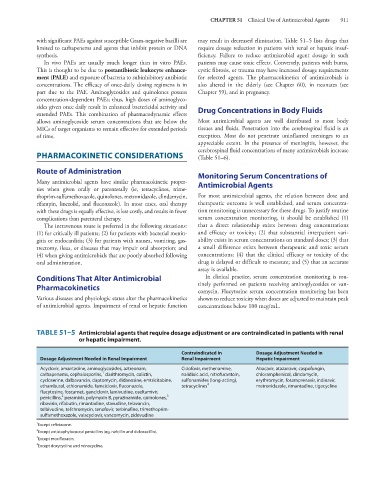Page 925 - Basic _ Clinical Pharmacology ( PDFDrive )
P. 925
CHAPTER 51 Clinical Use of Antimicrobial Agents 911
with significant PAEs against susceptible Gram-negative bacilli are may result in decreased elimination. Table 51–5 lists drugs that
limited to carbapenems and agents that inhibit protein or DNA require dosage reduction in patients with renal or hepatic insuf-
synthesis. ficiency. Failure to reduce antimicrobial agent dosage in such
In vivo PAEs are usually much longer than in vitro PAEs. patients may cause toxic effects. Conversely, patients with burns,
This is thought to be due to postantibiotic leukocyte enhance- cystic fibrosis, or trauma may have increased dosage requirements
ment (PALE) and exposure of bacteria to subinhibitory antibiotic for selected agents. The pharmacokinetics of antimicrobials is
concentrations. The efficacy of once-daily dosing regimens is in also altered in the elderly (see Chapter 60), in neonates (see
part due to the PAE. Aminoglycosides and quinolones possess Chapter 59), and in pregnancy.
concentration-dependent PAEs; thus, high doses of aminoglyco-
sides given once daily result in enhanced bactericidal activity and Drug Concentrations in Body Fluids
extended PAEs. This combination of pharmacodynamic effects
allows aminoglycoside serum concentrations that are below the Most antimicrobial agents are well distributed to most body
MICs of target organisms to remain effective for extended periods tissues and fluids. Penetration into the cerebrospinal fluid is an
of time. exception. Most do not penetrate uninflamed meninges to an
appreciable extent. In the presence of meningitis, however, the
cerebrospinal fluid concentrations of many antimicrobials increase
PHARMACOKINETIC CONSIDERATIONS (Table 51–6).
Route of Administration Monitoring Serum Concentrations of
Many antimicrobial agents have similar pharmacokinetic proper- Antimicrobial Agents
ties when given orally or parenterally (ie, tetracyclines, trime-
thoprim-sulfamethoxazole, quinolones, metronidazole, clindamycin, For most antimicrobial agents, the relation between dose and
rifampin, linezolid, and fluconazole). In most cases, oral therapy therapeutic outcome is well established, and serum concentra-
with these drugs is equally effective, is less costly, and results in fewer tion monitoring is unnecessary for these drugs. To justify routine
complications than parenteral therapy. serum concentration monitoring, it should be established (1)
The intravenous route is preferred in the following situations: that a direct relationship exists between drug concentrations
(1) for critically ill patients; (2) for patients with bacterial menin- and efficacy or toxicity; (2) that substantial interpatient vari-
gitis or endocarditis; (3) for patients with nausea, vomiting, gas- ability exists in serum concentrations on standard doses; (3) that
trectomy, ileus, or diseases that may impair oral absorption; and a small difference exists between therapeutic and toxic serum
(4) when giving antimicrobials that are poorly absorbed following concentrations; (4) that the clinical efficacy or toxicity of the
oral administration. drug is delayed or difficult to measure; and (5) that an accurate
assay is available.
Conditions That Alter Antimicrobial In clinical practice, serum concentration monitoring is rou-
Pharmacokinetics tinely performed on patients receiving aminoglycosides or van-
comycin. Flucytosine serum concentration monitoring has been
Various diseases and physiologic states alter the pharmacokinetics shown to reduce toxicity when doses are adjusted to maintain peak
of antimicrobial agents. Impairment of renal or hepatic function concentrations below 100 mcg/mL.
TABLE 51–5 Antimicrobial agents that require dosage adjustment or are contraindicated in patients with renal
or hepatic impairment.
Contraindicated in Dosage Adjustment Needed in
Dosage Adjustment Needed in Renal Impairment Renal Impairment Hepatic Impairment
Acyclovir, amantadine, aminoglycosides, aztreonam, Cidofovir, methenamine, Abacavir, atazanavir, caspofungin,
1
carbapenems, cephalosporins, clarithromycin, colistin, nalidixic acid, nitrofurantoin, chloramphenicol, clindamycin,
cycloserine, dalbavancin, daptomycin, didanosine, emtricitabine, sulfonamides (long-acting), erythromycin, fosamprenavir, indinavir,
ethambutol, ethionamide, famciclovir, fluconazole, tetracyclines 4 metronidazole, rimantadine, tigecycline
flucytosine, foscarnet, ganciclovir, lamivudine, oseltamivir,
2
penicillins, peramivir, polymyxin B, pyrazinamide, quinolones, 3
ribavirin, rifabutin, rimantadine, stavudine, telavancin,
telbivudine, telithromycin, tenofovir, terbinafine, trimethoprim-
sulfamethoxazole, valacyclovir, vancomycin, zidovudine
1 Except ceftriaxone.
2 Except antistaphylococcal penicillins (eg, nafcillin and dicloxacillin).
3
Except moxifloxacin.
4
Except doxycycline and minocycline.

